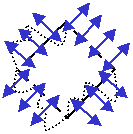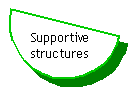Towards a Model of Self-Organised Transformation
in Teams & Organisations
{To download a Word version, click here.}
I offer here some preliminary thoughts on a model of organisational change which has been floating around in my mind for a while. It is far from finished and may need to be completely discarded (models should never be kept when they serve no purpose—“All models are wrong, some models are useful”; Box 1979:202). Please read it in a spirit of collaborative inquiry and let me have any thoughts or feedback which seem appropriate. My aim is to capture some of the elements which seem important for effective self-organised change:

The paragraphs below give more
information on the elements in the model:
The fractal nature of the model
It seems to me that this model has a certain fractal quality; that it is applicable at a number of levels—certainly for both whole organisations and for teams/departments within an organisation. Although there will be significant differences in detail between the two cases, I believe that they are sufficiently similar (because of the fractally hierarchical nature of complex systems) to be treated as different in degree but not kind. Accordingly I will write of ‘team or organisation’ without considering too much the detailed differences between the cases.
The team or organisation
 The
lozenge represents the system—team or organisation—which is looking to achieve
self-organised transformation. The black dotted line shows a strong boundary around the
system, necessary to self-organisation to occur. Within this boundary the people in the
system are free to interact as they think appropriate. The red swirls represent those
interactions, each affecting and feeding off each other. It may be appropriate to
articulate a set of simple rules to aid this process (Eisenhardt & Sull 2001, IOM
2001, Seel 2003).
The
lozenge represents the system—team or organisation—which is looking to achieve
self-organised transformation. The black dotted line shows a strong boundary around the
system, necessary to self-organisation to occur. Within this boundary the people in the
system are free to interact as they think appropriate. The red swirls represent those
interactions, each affecting and feeding off each other. It may be appropriate to
articulate a set of simple rules to aid this process (Eisenhardt & Sull 2001, IOM
2001, Seel 2003).
The boundaries
 The strong
dashed black border around the lozenge indicates the need for good boundaries when
facilitating emergence. Initially these are likely to be set by senior management,
probably along the lines of ‘common law’ rules—whatever is not prohibited
is permitted—with a clear set of understandings of what is not acceptable (see White
1999 for more on common law and roman law rules).
The strong
dashed black border around the lozenge indicates the need for good boundaries when
facilitating emergence. Initially these are likely to be set by senior management,
probably along the lines of ‘common law’ rules—whatever is not prohibited
is permitted—with a clear set of understandings of what is not acceptable (see White
1999 for more on common law and roman law rules).
The dotted irregular lines indicate that in a truly adaptive system the boundaries will be constantly co-created, perhaps through a process of variation, selection and retention (Cambell 1965).
 Permeability
Permeability
Strong and effective boundaries are never impermeable. The self-organising system must have good connectivity if it is to be adaptive. So, for instance, there must be strong links with other teams or organisations. Without this, learning from peers cannot take place. Similarly, there need to be strong active two-way links with customers, whether internal or external; with the environment or business ecosystem and with other parts of the organisation or with suppliers and competitors if the whole organisation is the system under consideration.
 The vision
The vision
In many complex systems ‘self-organisation happens’. Whatever emerges will be unpredictable and surprising. This is still true to some extent in human systems but there is a big difference between human and other complex systems. In a human system the ‘agents’ have self-awareness, volition and intentionality. They can make choices and modify their behaviour and rules of engagement in ways that may take them closer to a goal.
It is my belief that human beings have the ability to influence the outcome of emergent change (see Cooperrider 1990 for some supporting arguments). The outcome will still be surprising and unpredictable in detail but not completely unexpected. This can be found even in inanimate systems—weather is unpredictable in anything but the short-term but climate is fairly predictable over many years.
A clear sense of vision and purpose can make a major difference to self-organised change. (“Where there is no vision, the people perish”: Proverbs 29:18) It needs to be specific enough to be energising but loose enough to allow scope for individual participation. Vision will usually be set by senior management but the greater the involvement of the whole organisation in its creation, the more effective it is likely to be.
 Supportive structures
Supportive structures
Structures cannot create organisational change but they can certainly hinder it. If a team or organisation tries to go for a self-organising approach, perhaps with self-managed teams or some other initiative, it must ensure that the organisational structures are appropriate. The model offers a selection of structural considerations which need to be looked and adjusted as appropriate.
Adaptive strategy
Strategy needs to be appropriate to self-organising transformation. The emphasis will be upon ecosystem scanning, exploring possibility spaces by means of approaches such as scenarios, and learning rather than predicting.
Communication methods
Good communication is essential, of course. But it also needs to be appropriate. Telling is fine for boundary setting and information giving but participative inquiry is needed to sustain self-organisation. Most organisations are much better at advocacy than inquiry (see Senge et al 1994) and have a lot to learn in this area.
Feedback systems
Any adaptive organisation needs good feedback. Possible approaches in the case of self-organised transformation include formal implementation groups, ‘change champions’ and (probably best of all) self-selecting groups with a passion for change who take informal responsibility for monitoring and feeding back on progress (see Shaw 1997).
Reporting structures
Excessive hierarchy or inappropriate exercise of power will inhibit emergent change. The role of managers must change to become facilitative and enabling. Coaching and counselling become key skills. At the same time, managers have a greater onus to be guardians of standards if, and only if, these break down in the team or organisation. Adaptive management is not all warm and fuzzy—it requires ‘tough love’ if the organisation is to thrive.
Reward & recognition
Individual-based reward & recognition is not usually appropriate in self-organising environments. However, it is not necessary to try to avoid all kinds of competition between individuals and teams. Rather, reward & recognition schemes should attempt to find an appropriate (as ever, the word ‘appropriate’ means determined by adaptive experimentation and learning) balance between competition and collaboration.
Selection & recruitment
It makes sense to recruit people who are most likely to thrive in self-organising systems. This may mean inquiring into tolerance for ambiguity and attitudes towards flexibility and innovation. Training and development should also be geared towards helping staff develop skills which will support them in what for many are new and scary ways of working.
Systems & processes
Appropriate systems and process can support self-organised change. The reverse is also all too possible. IT solutions such as connectivity though intranet chat rooms, just-in-time e-learning, integrated customer databases, simulations of proposed innovations and so on can greatly help the adaptive organisation.
Supportive culture
 Most failed change programmes founder on the icebergs of
organisational culture. Unless the culture is also changed, old patterns of behaviour
reassert themselves. New ways of working, in themselves, will not change a culture; rather
they need to form a symbiotic relationship with cultural inquiry and reassessment. For
instance, a ‘blame culture’ will not support self-organisation; it needs to be
superseded by an ‘encouragement culture’ or a ‘forgiveness culture’
(Seel 2000)
Most failed change programmes founder on the icebergs of
organisational culture. Unless the culture is also changed, old patterns of behaviour
reassert themselves. New ways of working, in themselves, will not change a culture; rather
they need to form a symbiotic relationship with cultural inquiry and reassessment. For
instance, a ‘blame culture’ will not support self-organisation; it needs to be
superseded by an ‘encouragement culture’ or a ‘forgiveness culture’
(Seel 2000)
Summary
The model is tentative, an attempt to encapsulate some thoughts about how to implement self-organising emergent change in the current organisational climate. It doesn’t seem very revolutionary but I have tried to mix some of the new thinking from complexity theory with some pragmatic considerations based on where organisations currently are. All comments welcome.
References
Box, George E. P. 1979, “Robustness in the Strategy of Scientific Model Building”, in Launer, R. L. & Wilkinson, G. N. Robustness in Statistics. New York: Academic Press, p. 202.
Campbell, D. T. 1965, “Variation and Selective Retention in Socio-Cultural Evolution.” In H. R. Barringer, G. I. Blanksten and R. W. Mack (eds), Change in Developing Areas: A Reinterpretation of Evolutionary Theory. Cambridge, Mass: Schenckman.
Cooperrider, David 1999, “Positive Image, Positive Action: The Affirmative Basis of Organizing”, In Srivastva and Cooperrider et al Appreciative Management & Leadership, San Francisco: Jossey-Bass.
Eisenhardt, Kathleen M. & Sull, Donald 2001, “Strategy as Simple Rules”, Harvard Business Review, January, pp 107-116.
Institute of Medicine 2001, Crossing the Quality Chasm: A New System for the 21st Century, National Academy Press.
Seel, Richard 2003, “Describing Culture: From Diagnosis to Inquiry”
Senge, Peter, Kleiner, Art,
Roberts, Charlotte, Ross, Richard & Smith, Bryan 1994, The Fifth Discipline: The
Art and Practice of the Learning Organization. London: Nicholas Brealey.
Shaw, Patricia (1997)
“Intervening in the Shadow Systems of Organizations: Consulting from a Complexity
Perspective.” Journal of Organizational Change Management 10(3): 235-250.
White, Mark 1999, “Adaptive Corporations” in Michael R. Lissack and Hugh P. Gunz (eds) Managing Complexity in Organizations A View in Many Directions Westport, Conn.: Quorum Books.
© 2001 Richard Seel.
This article is indexed here.





